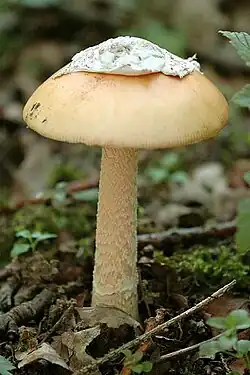Amanita kotohiraensis
| Amanita kotohiraensis | |
|---|---|

| |
| Scientific classification | |
| Kingdom: | Fungi |
| Division: | Basidiomycota |
| Class: | Agaricomycetes |
| Order: | Agaricales |
| Family: | Amanitaceae |
| Genus: | Amanita |
| Species: | A. kotohiraensis
|
| Binomial name | |
| Amanita kotohiraensis Nagas. & Mitani
| |
| Amanita kotohiraensis | |
|---|---|
| Gills on hymenium | |
| Cap is convex or flat | |
| Hymenium is free | |
| Stipe has a ring and volva | |
| Spore print is white | |
| Ecology is mycorrhizal | |
| Edibility is poisonous | |
Amanita kotohiraensis is a species of highly toxic fungus in the family Amanitaceae native to parts of China and Japan.
A review of cases in southern China finding it had been responsible for 91 poisoning cases, 1 of which was fatal, between 1994 and 2012.[1]
References
- ^ Zuohong Chen & Ping Zhang & Zhiguang Zhang (2014). "Investigation and analysis of 102 mushroom poisoning cases in Southern China from 1994 to 2012". Fungal Diversity. 64: 123–31. doi:10.1007/s13225-013-0260-7. S2CID 5341127.
